Training your forearms is a vital part of growing and carving your arms. Whether you are a workout pro or devising your first training plan, the exercises below will help you meet your fitness goals.
dumbbell seated palms up wrist curl
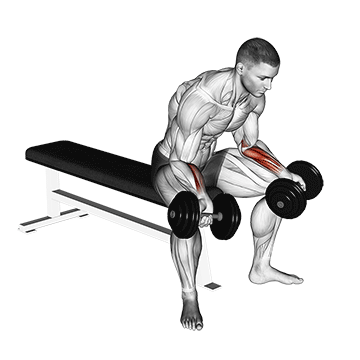
1. Start by sitting on a flat bench with your feet firmly planted on the ground.
2. Hold a dumbbell in each hand with your palms facing upwards.
3. Rest your forearms on your thighs, allowing your wrists to hang over the edge of your knees.
4. Slowly lower the dumbbells as far as possible by bending your wrists.
5. Pause for a moment at the bottom of the movement, then curl the dumbbells back up towards your forearms by flexing your wrists.
6. Squeeze your forearms at the top of the movement and hold for a second.
7. Repeat this movement for your desired number of repetitions.
8. Remember to keep your forearms stationary throughout the exercise, moving only your wrists.
9. Ensure to use a weight that is challenging but allows you to maintain proper form.
10. Breathe in as you lower the dumbbells and breathe out as you curl them back up.
This exercise is great for strengthening and toning your forearms. Be sure to perform it slowly and with control for maximum effectiveness.
dumbbell seated one arm rotate
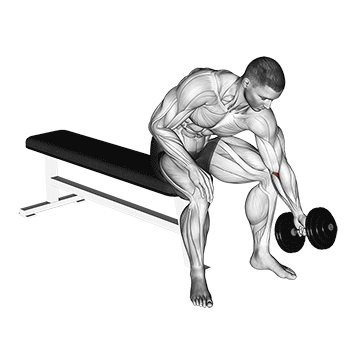
1. Start by sitting on a flat bench with your feet firmly planted on the ground.
2. Grab a dumbbell with your right hand, ensuring your grip is firm but not overly tight.
3. Rest your right elbow on your right thigh, letting the dumbbell hang down towards the ground. Your palm should be facing towards your body.
4. Slowly rotate your wrist upwards, lifting the dumbbell as high as you can. Ensure the movement is controlled and only your forearm is moving.
5. Hold this position for a second, feeling the contraction in your forearm.
6. Slowly lower the dumbbell back to the starting position, again ensuring the movement is controlled.
7. Repeat this movement for your desired number of repetitions.
8. Once you have completed your set, switch to your left hand and repeat the exercise.
Remember to keep your back straight and your core engaged throughout the exercise. The key to this exercise is slow, controlled movements, not the weight of the dumbbell.
dumbbell reverse wrist curl
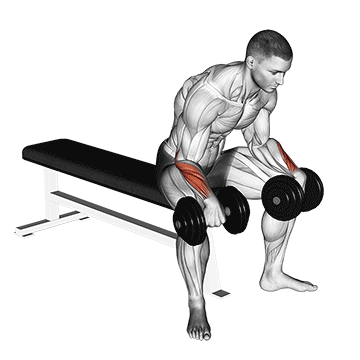
1. Start by selecting a dumbbell of appropriate weight. Remember, it's better to start light and gradually increase the weight as your strength improves.
2. Stand or sit on a bench with your feet shoulder-width apart. If you're sitting, ensure your knees are bent at a 90-degree angle and your feet are flat on the floor.
3. Hold the dumbbell in your right hand with an overhand grip, meaning your palm should be facing towards you.
4. Rest your forearm on your thigh or a bench with your wrist and the dumbbell hanging over the edge. Ensure your arm is fully extended and your wrist is in a neutral position.
5. Slowly lower the dumbbell as far as you can, bending your wrist towards the floor. This is the starting position.
6. Now, curl the dumbbell upwards by flexing your wrist towards your body. Continue this movement until your forearm is fully contracted and the dumbbell is at the same level as the bench or your thigh.
7. Hold this position for a second to maximize the contraction in the forearm muscles.
8. Gradually return to the starting position by lowering the dumbbell, extending your wrist and stretching your forearm.
9. Repeat the movement for the desired number of repetitions.
10. Once you've completed your set, switch the dumbbell to your left hand and repeat the exercise.
Remember to keep your forearm stationary throughout the exercise. The movement should only come from your wrist. Also, ensure you're controlling the dumbbell's movement, don't let it drop quickly.
dumbbell over bench wrist curl
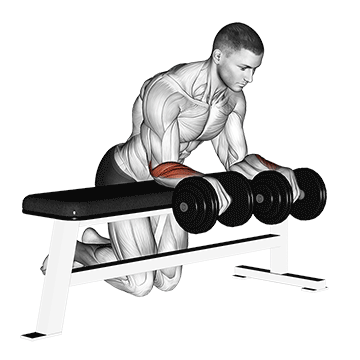
1. Start by selecting a dumbbell of appropriate weight. Remember, it's better to start light and gradually increase the weight as your strength improves.
2. Sit on the edge of a bench with your feet flat on the floor. Hold the dumbbell in your right hand with your palm facing up.
3. Rest your right forearm on your right thigh, allowing your wrist and the dumbbell to hang over the edge of your knee. Your forearm should be parallel to the floor.
4. Slowly lower the dumbbell as far as you can, bending at the wrist. This is your starting position.
5. Curl the dumbbell up as high as possible, keeping your forearm pressed against your thigh. Squeeze your forearm muscles at the top of the movement.
6. Slowly lower the dumbbell back to the starting position. This completes one repetition.
7. Perform your desired number of repetitions, then switch to your left hand and repeat the exercise.
8. Remember to keep your movements slow and controlled, focusing on the muscle contraction and not on the weights you are lifting.
9. Breathe in as you lower the dumbbell and breathe out as you curl it up.
10. Keep your back straight and avoid using your back or shoulders to lift the weight; your forearms should do all the work.
Remember, the key to this exercise is control, not speed. It's better to do fewer repetitions with good form than more with poor form.
dumbbell over bench revers wrist curl
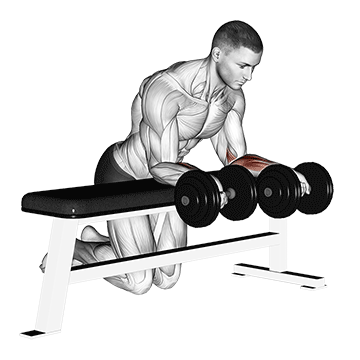
1. Start by selecting a dumbbell of appropriate weight. Remember, it's better to start light and increase weight as you get comfortable with the exercise.
2. Sit on the edge of a bench or chair, with your feet flat on the floor. Hold the dumbbell in your right hand with an overhand grip (palm facing down).
3. Rest your right forearm on your right thigh, with your wrist and the dumbbell hanging over the edge of your knee. Your arm should be perpendicular to the floor.
4. Slowly lower the dumbbell as far as you can, keeping your forearm pressed against your thigh. This is the starting position.
5. Curl the dumbbell up towards the ceiling as far as possible, while keeping your forearm stationary. Ensure only your hand and the wrist are moving.
6. Hold the contraction at the top for a second, then slowly lower the dumbbell back to the starting position.
7. Repeat for the desired number of repetitions. Once you're done, switch to your left hand and repeat the exercise.
8. Remember to keep your movements slow and controlled, focusing on the muscle contraction and not on the weights you are lifting.
9. Breathe in as you lower the dumbbell, and breathe out as you curl it up.
10. Always maintain a straight back and avoid any kind of jerky movements to prevent injury.
This exercise is great for strengthening your forearms and improving grip strength.
dumbbell over bench one arm wrist curl
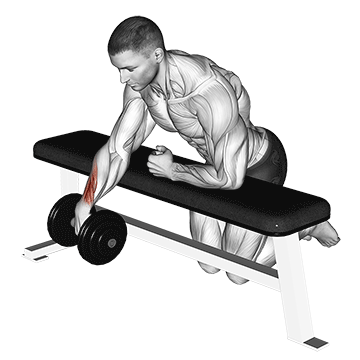
1. Start by selecting a dumbbell of appropriate weight. Remember, it's better to start light and increase weight as needed to avoid injury.
2. Sit on the edge of a bench or chair, with your feet flat on the floor, shoulder-width apart.
3. Hold the dumbbell in your right hand with an underhand grip (palm facing upwards).
4. Rest your right forearm on your right thigh, with your wrist and the dumbbell hanging over the edge of your knee.
5. Keep your arm stationary, and use your wrist to lift the dumbbell as high as possible. Ensure that you keep your grip firm and do not let the dumbbell slip.
6. Hold the position at the top for a moment, then slowly lower the dumbbell back to the starting position.
7. Repeat this movement for your desired number of repetitions.
8. Once you've completed your set, switch the dumbbell to your left hand and repeat the exercise for the same number of repetitions.
Remember to keep your movements controlled and steady, focusing on the contraction and extension of your forearm muscles. Avoid using your upper arm or shoulder to lift the weight; your wrist should be doing all the work.
dumbbell over bench one arm reverse wrist curl
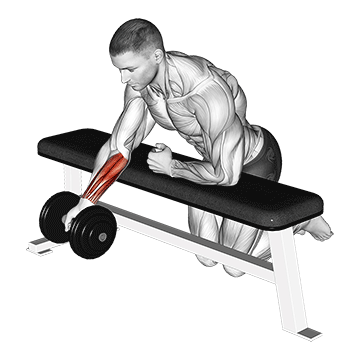
1. Start by selecting a dumbbell of appropriate weight. Remember, it's better to start light and gradually increase the weight as your strength improves.
2. Sit on the edge of a bench or chair, with your feet flat on the floor. Hold the dumbbell in one hand with your palm facing down.
3. Rest your forearm on your thigh or another bench, allowing your wrist and the dumbbell to hang over the edge. Your arm should be perpendicular to the floor.
4. Slowly curl the dumbbell upwards by flexing your wrist. Keep your forearm stationary and use only your wrist to lift the weight.
5. Pause for a moment at the top of the movement, then slowly lower the dumbbell back to the starting position. This completes one repetition.
6. Perform your desired number of repetitions, then switch to the other arm and repeat the exercise.
7. Remember to keep your movements slow and controlled, focusing on the muscle contraction and not on the weights you are lifting.
8. Avoid using your arm or shoulder to lift the weight; your wrist should be doing all the work.
9. Keep your back straight and avoid any kind of body movement. The only part that should be moving is your wrist.
10. Breathe in as you lower the weight and breathe out as you curl the weight upwards.
Remember, consistency is key in any workout routine. Perform this exercise regularly for best results.
dumbbell one arm wrist curl
1. Start by selecting a dumbbell of appropriate weight. Remember, it's better to start light and gradually increase the weight as your strength improves.
2. Sit on the edge of a bench or chair, holding the dumbbell in your right hand. Your feet should be flat on the floor, shoulder-width apart.
3. Rest your right forearm on your right thigh, with your hand hanging over the edge of your knee, palm facing upwards.
4. Slowly curl the dumbbell upwards, bending at the wrist. Keep your forearm and the rest of your body still, focusing the movement solely on your wrist.
5. Once your wrist is fully flexed, pause for a moment, then slowly lower the dumbbell back to the starting position.
6. Repeat this movement for your desired number of repetitions.
7. Once you've completed your set, switch the dumbbell to your left hand and repeat the exercise with your left wrist.
8. Remember to keep your movements slow and controlled, focusing on the muscle contraction and not on the weights you're lifting.
9. Breathe in as you lower the dumbbell and breathe out as you curl it up.
10. Aim for 2-3 sets of 10-15 repetitions on each arm.
This exercise can be done 2-3 times a week as part of your strength training routine. Always ensure you're using proper form to avoid injury and maximize results.
dumbbell one arm seated neutral wrist curl
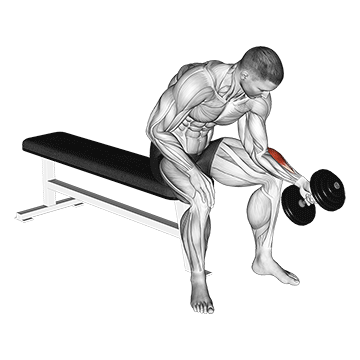
1. Begin by sitting on a flat bench with your feet firmly planted on the ground.
2. Hold a dumbbell in one hand with your palm facing upwards.
3. Rest your elbow on your thigh, allowing your wrist to hang over the edge of your knee.
4. Slowly lower the dumbbell as far as possible, keeping your forearm in contact with your thigh.
5. Once you've reached the bottom of the movement, curl the dumbbell back up towards your forearm, contracting your forearm muscles.
6. Hold this position for a moment, squeezing your forearm muscles at the top of the movement.
7. Slowly lower the dumbbell back down to the starting position.
8. Repeat this movement for your desired number of repetitions.
9. Once you've completed your set, switch arms and repeat the exercise.
Remember to keep your movements slow and controlled, focusing on the muscle contraction and not on the weights you are lifting. Also, ensure your forearm remains in contact with your thigh throughout the exercise to isolate the forearm muscles.
dumbbell one arm revers wrist curl
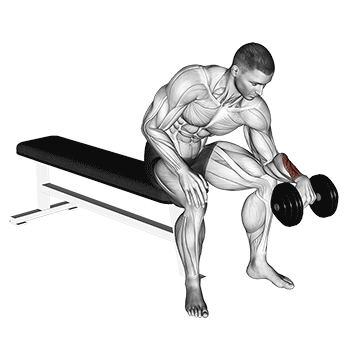
1. Start by selecting a dumbbell of appropriate weight. Remember, it's better to start light and gradually increase the weight as your strength improves.
2. Stand or sit on a bench with your feet shoulder-width apart. Hold the dumbbell in one hand with your palm facing down (overhand grip).
3. Rest your forearm on your thigh or a bench, with your wrist and the dumbbell hanging over the edge. Your arm should be fully extended.
4. Slowly curl the dumbbell upwards by bending your wrist. Keep your forearm stationary throughout the movement.
5. Pause for a moment at the top of the movement, then slowly lower the dumbbell back to the starting position. This completes one repetition.
6. Perform your desired number of repetitions, then switch to the other arm and repeat the exercise.
7. Remember to keep your movements controlled and steady. Avoid using your upper arm or shoulder to lift the weight; your wrist should be doing all the work.
8. Breathe in as you lower the dumbbell and breathe out as you curl it upwards.
9. For optimal results, aim for 2-3 sets of 10-15 repetitions on each arm.
Remember, the key to this exercise is control, not speed. It's more important to perform each repetition correctly than to rush through them.
dumbbell lying supination on floor
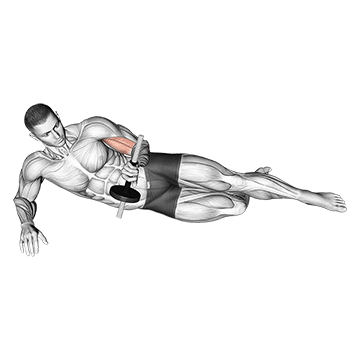
1. Start by selecting a dumbbell of appropriate weight. Remember, it's always better to start with a lighter weight and gradually increase as you get comfortable with the exercise.
2. Lie down flat on your back on the floor. Keep your feet flat on the ground and your knees bent.
3. Hold the dumbbell in your right hand with your arm extended straight up towards the ceiling. Your palm should be facing towards your feet.
4. Slowly rotate your forearm so that your palm is now facing towards your head. This is the supination part of the exercise. Ensure that the movement is controlled and only your forearm is moving. Your upper arm should remain stationary.
5. Rotate your forearm back to the starting position, with your palm facing towards your feet. This completes one rep.
6. Perform the desired number of reps on your right arm before switching to your left arm and repeating the process.
7. Remember to keep your movements slow and controlled throughout the exercise. This will ensure that your forearm muscles are fully engaged and you're getting the most out of the exercise.
8. As with any exercise, it's important to maintain proper form throughout. Avoid any jerky or rapid movements, as this can lead to injury.
9. If you find the exercise too easy, you can increase the weight of the dumbbell. If it's too difficult, decrease the weight or the number of reps.
10. This exercise can be incorporated into your regular workout routine to help strengthen and tone your forearms.
dumbbell lying supination
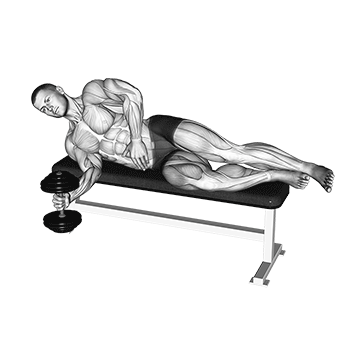
1. Start by selecting a dumbbell of appropriate weight. Remember, it's always better to start light and gradually increase the weight as you get comfortable with the exercise.
2. Lie down on a flat bench with your feet firmly planted on the ground. Hold the dumbbell in your right hand with a neutral grip, meaning your palm should be facing towards your torso.
3. Extend your arm fully so that it is perpendicular to the floor. This is your starting position.
4. Slowly rotate your wrist inward until your palm is facing up. Ensure that the movement is controlled and only your forearm is moving. Your upper arm should remain stationary throughout the exercise.
5. Hold this position for a second, feeling the contraction in your forearm.
6. Gradually rotate your wrist back to the starting position. This completes one rep.
7. Repeat the exercise for the desired number of repetitions. Once you're done, switch to your left hand and perform the same number of repetitions.
8. Remember to keep your movements slow and controlled. Avoid using your upper arm or shoulder to lift the weight, as this can lead to injury and won't effectively target your forearms.
9. As you get stronger, you can increase the weight of the dumbbell or the number of repetitions to continue challenging your muscles.
10. Always ensure to maintain proper form throughout the exercise to maximize its effectiveness and prevent any potential injuries.
dumbbell lying pronation on floor
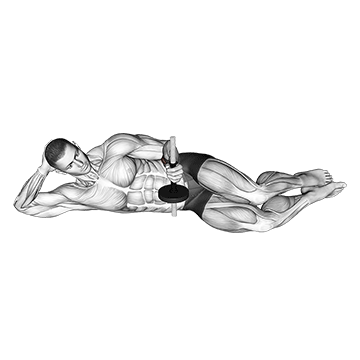
1. Start by selecting a dumbbell of appropriate weight. Remember, it's better to start light and gradually increase the weight as your strength improves.
2. Lie down flat on your back on a comfortable, flat surface such as a yoga mat or carpeted floor.
3. Hold the dumbbell in your right hand with your arm fully extended towards the ceiling. Your palm should be facing towards your feet. This is your starting position.
4. Slowly rotate your wrist inward, turning your palm to face towards your head. Keep your arm straight and still throughout this movement, ensuring only your forearm is moving.
5. Once your palm is facing towards your head, pause for a moment, then slowly rotate your wrist back to the starting position.
6. Repeat this movement for your desired number of repetitions.
7. Once you've completed your set, switch the dumbbell to your left hand and repeat the exercise.
8. Remember to keep your movements slow and controlled, focusing on the rotation of your wrist and the contraction of your forearm muscles.
9. Breathe in as you rotate your wrist inward, and breathe out as you return to the starting position.
10. Ensure to maintain a good form throughout the exercise to prevent any injuries and to maximize the effectiveness of the exercise.
Remember, the key to this exercise is the rotation of the wrist, not the movement of the arm. Keep your arm still and focus on moving your wrist to target your forearm muscles.
dumbbell lying pronation
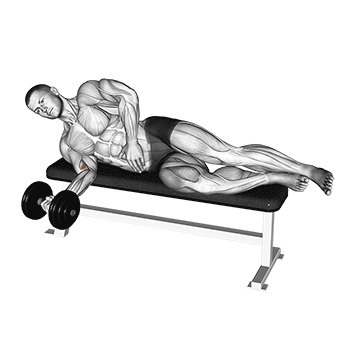
1. Start by selecting a dumbbell of appropriate weight. Remember, it's better to start light and gradually increase the weight as your strength improves.
2. Lie down on a flat bench with your feet firmly planted on the ground. Hold the dumbbell in your right hand with a neutral grip, meaning your palm should be facing towards your torso.
3. Extend your right arm straight up towards the ceiling. This is your starting position.
4. Slowly rotate your wrist inward so that your palm is facing away from your body. Ensure that the movement is controlled and only your forearm is moving. Your upper arm should remain stationary throughout the exercise.
5. Hold this position for a second, feeling the contraction in your forearm.
6. Slowly rotate your wrist back to the starting position. This completes one rep.
7. Perform the desired number of reps on your right arm before switching to your left arm.
8. Remember to keep your movements slow and controlled, focusing on the muscle contraction and not on the weights you are lifting.
9. Repeat for the desired number of sets.
Remember to always maintain proper form and never try to lift more weight than you can handle safely. This exercise can also be performed while sitting on a bench, but lying down can provide more stability.
dumbbell finger curls
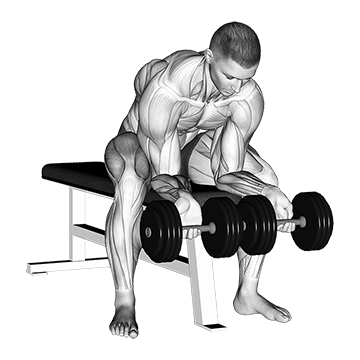
1. Start by selecting a dumbbell of appropriate weight. If you're new to this exercise, start with a lighter weight to avoid straining your muscles.
2. Stand up straight with your feet shoulder-width apart. Hold the dumbbell in your hand with your palm facing upwards.
3. Extend your arm down fully, allowing the dumbbell to hang at arm's length. This is your starting position.
4. Slowly curl your fingers towards your palm, lifting the dumbbell as you do so. Ensure that the movement is controlled and only your fingers are moving, not your wrist or arm.
5. Once you've curled your fingers as far as you can, pause for a moment and squeeze your forearm muscles.
6. Slowly uncurl your fingers to lower the dumbbell back to the starting position. This completes one rep.
7. Repeat the exercise for your desired number of reps, then switch hands and perform the same number of reps with your other hand.
8. For best results, aim to complete 2-3 sets of 10-15 reps for each hand. Remember to rest for a minute or two between sets.
Remember, the key to this exercise is control. Don't rush the movements, and make sure you're really working your forearm muscles. If the weight is too heavy and you can't maintain control, reduce the weight.
No tags for this post.
